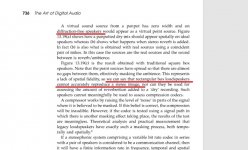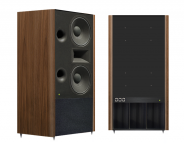Jay111, Renton, thank you for the input.
I wonder if BBC still use those classic BBC monitors in their studios. I liked them a lot.
Not exclusively but I have seen the larger designs in their studios. The Harbeths are common stand-ins for earlier designs. The designs are also licensed to Stirling Broadcast and Graham Audio who provide drop-in replacements for older models. To be used or licensed he sound balance has to be similar. Power handling is usually increased through more modern drive units.
an example of what Melo means would be a baffle the width of a chello will enhance the sound characteristic or "spectrum" of similarly wide instruments.
Exactly.
Maybe this is the reason some reviewers state that certain speakers produce vocals better. This may not be because they cater to those frequencies, but rather that their diffraction resembles that of a human head.
Can be of interest here:
We need to talk about SPEAKERS: Sorry, 'audiophiles', only IT will break the sound barrier ? The Register
Point spread function (left) before servicing (right):

We need to talk about SPEAKERS: Sorry, 'audiophiles', only IT will break the sound barrier ? The Register
Most legacy speakers have massive point spread functions due to diffraction from inept enclosure design and their stereophonic images are badly smeared.
Point spread function (left) before servicing (right):

ps.
from the same author:
https://books.google.pl/books?id=Ch...EPPWRgMAK&ved=0CDUQ6AEwAw#v=onepage&q&f=false
from the same author:
https://books.google.pl/books?id=Ch...EPPWRgMAK&ved=0CDUQ6AEwAw#v=onepage&q&f=false
Attachments
Greebster, Melo Theory,
I think it explains a lot about the question I have.
Since most of the musical instruments except piano and pipe organs are about the same human size, I guess those sharp edged speakers may intend to focus on vocals or each instruments, rather than focus on the whole sound stage. Small speakers may project miniature sized image. ATCs are not good speakers in terns of the sound stage, but they do project very believable image of the each instrument. I guess BBC monitors may focus on the human voices.
I still think the old style horn speakers with bad horn edge diffraction are the best for Rudy Van Gelder recordings, but it's probably because the diffraction of the horn imitates the sax or trumpet very well. They sound horrible for the classical recordings, though. I think the speakers failed to control diffraction tend to project in your face image of the each instruments, on the other hand, the speakers that control the diffraction very well tend to project huge sound stage behind the speakers, like electrostatics.
I don't know if I'm correct..
I think it explains a lot about the question I have.
Since most of the musical instruments except piano and pipe organs are about the same human size, I guess those sharp edged speakers may intend to focus on vocals or each instruments, rather than focus on the whole sound stage. Small speakers may project miniature sized image. ATCs are not good speakers in terns of the sound stage, but they do project very believable image of the each instrument. I guess BBC monitors may focus on the human voices.
I still think the old style horn speakers with bad horn edge diffraction are the best for Rudy Van Gelder recordings, but it's probably because the diffraction of the horn imitates the sax or trumpet very well. They sound horrible for the classical recordings, though. I think the speakers failed to control diffraction tend to project in your face image of the each instruments, on the other hand, the speakers that control the diffraction very well tend to project huge sound stage behind the speakers, like electrostatics.
I don't know if I'm correct..
- Status
- This old topic is closed. If you want to reopen this topic, contact a moderator using the "Report Post" button.
- Home
- Loudspeakers
- Multi-Way
- What's with the sharp edges on speaker boxes these days?

